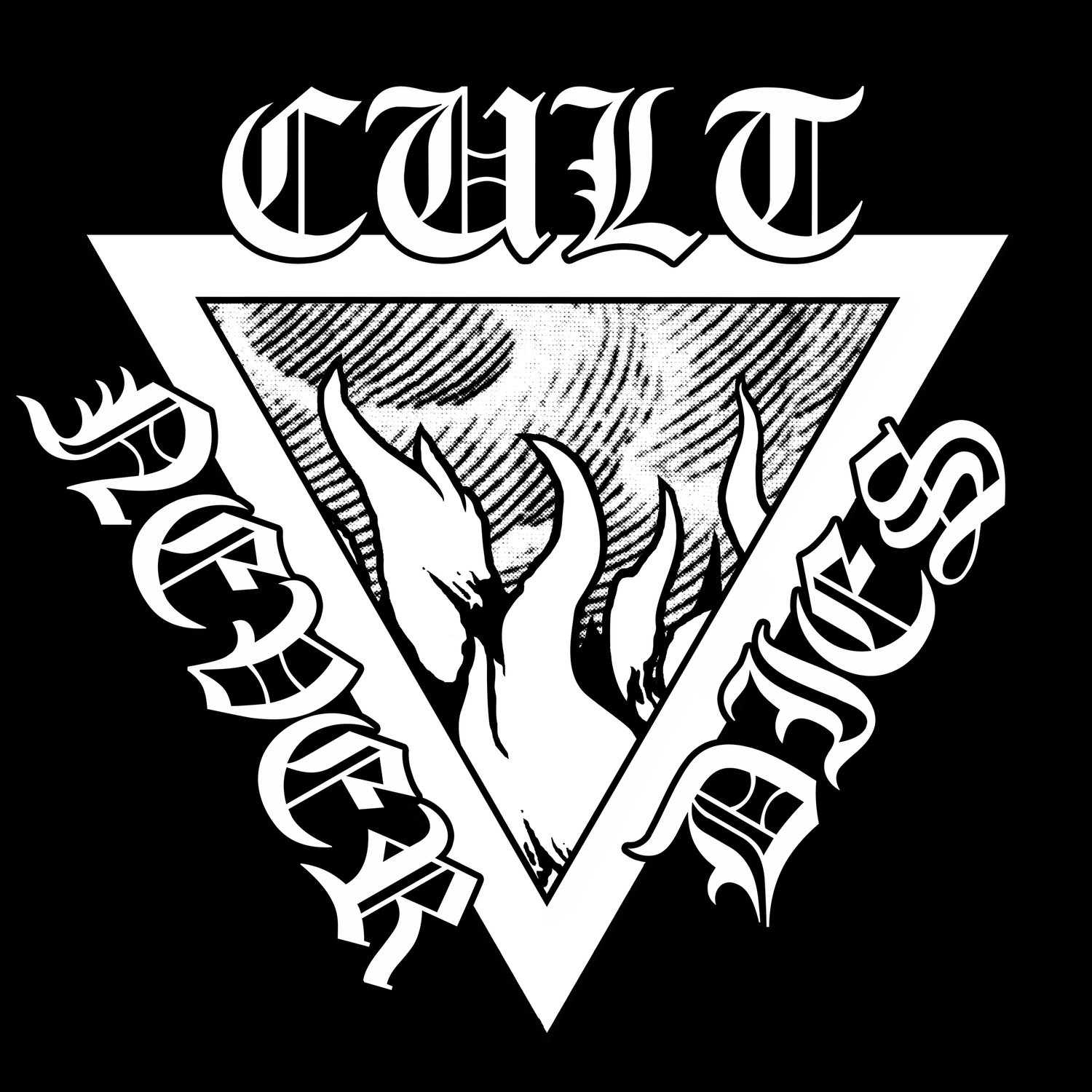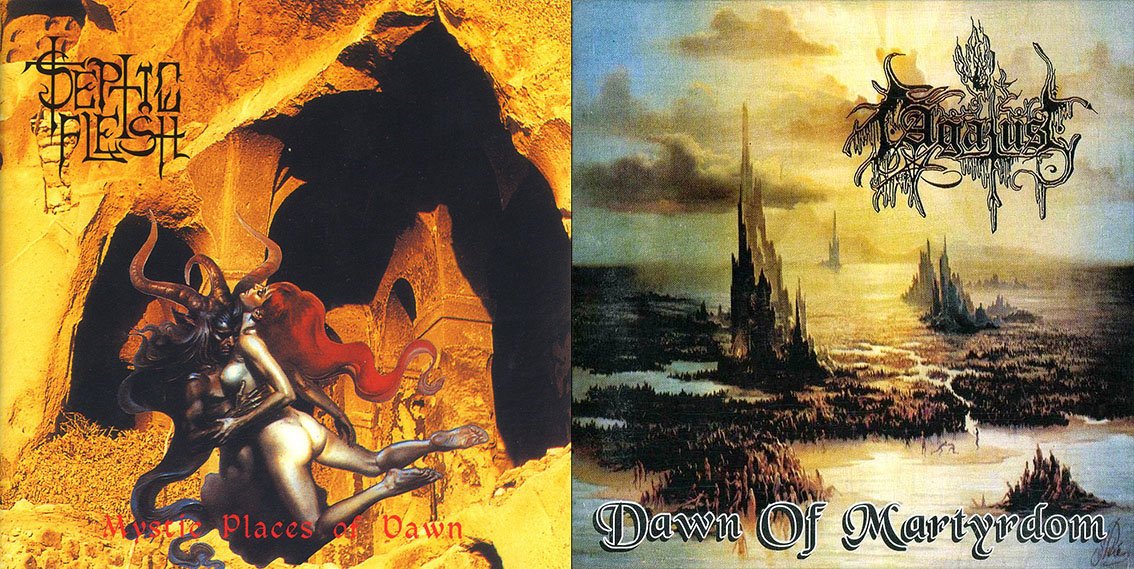One important ingredient in the making of Thy Mighty Contract – and indeed an important element in the story of early Rotting Christ – was Molon Lave Studio, the recording studio used to record the album. As the name suggests, this facility was owned by Molon Lave Records, a local label that had released albums and EPs by many of the Greek metal bands active at the time (including Flames, Thou Art Lord and Nightfall).
Its connections to underground metal meant that it offered a comfortable setting for local bands like Rotting Christ, who had previously been thrown out of studios by owners horrified by the harsh noise they were creating. In fact, the band were so happy with the facilities, that they – or at least two of the four members – decided to buy them, renaming it Storm Studio and going on to record a myriad of Greek metal bands there, including Varathron, Agatus, Kawir, Septic Flesh [Septic Flesh amended their name to Septicflesh in the mid 2000s, but to save confusion we will use the original moniker throughout this book] and many more.
Sakis: “Around the same time that we made this album Jim got some money – not sure where he got it but anyway, he asked me, ‘Would you like to start our own studio?’ and I said, ‘Yes, let’s do it’. So we bought this studio from Molon Lave, a very small place on the 4th or 5th floor of a tall building in the centre of Athens – in the same square in Exarchia we used to hang out in actually.”
Jim: “The studio was actually quite old and me and Sakis had to spend a lot of money buying new equipment for it when we set up Storm.”
Sakis: “In the same building as the studio was the office of Molon Lave Records and their record store was in the basement. Molon Lave had been set up by George Osmak, a guy from Yugoslavia who was maybe ten years older than us and was living permanently here in Athens. He had bought the studio and the record store in the basement and had started to release records by everyone in the Greek scene, from heavy metal to extreme black metal. He was a very busy guy – some people say he was a rip off and so on, but he did a lot for the Greek scene, released vinyl from most of the bands in the scene.”
In fact, the members of Rotting Christ had a fairly close relationship with Molon Lave around this time, even helping to set up a release for the label by the Portuguese band Moonspell, this starting a friendship between the two bands that has lasted to the present day.
Fernando Ribeiro (Moonspell): “Our old bass player Ares, who formed the band with me, was in touch with Jim Mutilator and he was the one who connected us with Molon Lave for the Goat On Fire 7-inch. That was quite a compliment for us as you might imagine. Both tracks are from our 1993 demo – nevertheless, we would release 1994’s Under The Moonspell first as we learnt that, like in Portugal, it was hard for the Greek to be timely with their releases [laughs]. But it became a cult object, with many bootleg versions afterwards, but I guess that’s the spirit.”
Sakis: “We actually signed with Molon Lave with Thou Art Lord – the owners of this label sold the studio to us, but kept the record store and the label until George moved to the US in 1995. It was already used by metal bands, so it was a good meeting point; go to the record store, go to the studio.”
Themis: “Actually the mother of Jim, and also our parents, helped with the money to get the studio. In ’86 Greece started to get money from the European union – we pay now, but everything changed after this, there was more money, everyone was building houses… as a country we got all the money and we spent it. And people were happy. That’s how we could steal money from our parents, because they didn’t give a shit. They started like poor guys, then they got to the age of about 35 and they started to realise a different kind of life, more fun, going out to eat, drinking, buying houses.”
Sakis: “I had already started working as a sound engineer by then. When I finished my education at the university I started studying sound engineering with Morbid. Jim was the owner of the studio, he provided most of the money, and George was engineering from the start, so it was the three of us. We began to record all the local bands there, bands like Nightfall, Septic Flesh – and Rotting Christ of course. I was also an owner and got maybe 20% and was also doing some of the engineering. It was not that successful financially – it was how you would expect a business run by some young guys like us to be – but it was very good for all the bands. People would hang out and at night everybody was there. It was really amazing to have this space.”
“My best days were from there, my best memories of the band. Many friends would come and go, bringing some drugs sometimes, bringing some alcohol, and we had a good time. We didn’t have any deadlines; it was our own studio so we had plenty of time to work. Again, we did it all for the idea, for the scene, to feel good, not to say, ‘Alright, let’s create a local scene that will be very powerful worldwide’ or something like that. We were friends with Necromantia, good friends with Varathron, Thou Art Lord was my other project, Zemial we were quite good friends with, we all hung out at the same pubs and so on.”
Morbid: “When Storm Studio was bought by Rotting Christ I was again the obvious choice – simple as that. It was difficult though; the studio was only 40 square metres with an analogue 16-track, and an analogue 2-track, no DAT. We also did not have a real drum set at Storm. We had a drum pads set. If a band wanted a real drum set they had to rent one themselves and bring it to the studio. Most of the time the bands were using a drum sequencer, meaning programmed drumming, like a drum machine. With Rotting Christ we used triggered drums, meaning real playing but with digital samples. I do not remember the kit we used, but it was an electronic drum kit – pads – and natural cymbals.”
“A lot of bands came to record with us after Thy Mighty Contract. It wasn’t that we had great equipment, but we were people that knew this music and that was rare. For example, one of the recordings we made with Necromantia, the sound guy just told us to get out and said that he would mix it. We came back later and he was very proud, pressed play and we listened and said, ‘It sounds like an L.A. band!’, we said, ‘Man, this is a rock remix, we don’t want that. It’s very nice but for a rock band’. Then we said, ‘Okay, you get out and we mix it ourselves’.”
“Overall, the studio actually had very average equipment and I had to think of tricks in order to bypass that. On the other hand, it forced me to think and create and not just ‘execute’. I really enjoyed my time there; I had first time experiences with most of the Greek bands of the age and had unlimited time to work on my other musical projects, like NAOS and Diabolos Rising. Sometimes it was really funny and I had to face conversations like:
Band: ‘We want to sound like X band.’
Me: ‘Okay, but you do not have the equipment and you are not that good as musicians.’
Or:
Me: ‘What you are playing is out of tune.’
Musician: ‘But this is the way I play it in the rehearsals."
Me: ‘You are playing it wrong in the rehearsals also’.”
Excerpt from Non Serviam: The Official Story of Rotting Christ by Sakis Tolis and Dayal Patterson.
ROTTING CHRIST INTERVIEW
FROM NON SERVIAM: THE OFFICIAL STORY OF ROTTING CHRIST
CHAPTER 10: STORM STUDIO (EXCERPT)
^ Sakis Tolis and Jim Mutilator at the entrance to the building in Exarchia which once housed the legendary Storm Studio, 2018 (Photo: Dayal Patterson)
^ Photos from Molon Lave Studio are rare indeed: these 1992 photos of hard rock band Silver R.I.S.C. (who signed to Molon Lave Records) gives some idea of how the place looked when Rotting Christ first encountered it.




